A link to the list itself can be found here.
In this article, I'll be covering all of the reasons as to why cards are on the list in the first place.
I'll also go into a bit of depth on how lists are made, and the general philosophy of the format.
If you're unfamiliar with Trinity, you can read an Introduction about it here!
Forbidden & Semi-Forbidden Cards
Decks can never include any "Forbidden" cards. Not under any circumstance. These cards are practically unusable. And that's a pretty big statement: not letting anyone ever use a certain card means that it either completely goes against everyone's good intentions, or is otherwise extremely powerful.
Semi-Forbidden is a specific position on the Trinity Forbidden List. For every 5 cards above the minimum maindeck size (30), that deck may include 1 extra copy of 1 Unlimited card or 1 Semi-Forbidden card. Because of this, decks rarely include many Semi-Forbidden cards. Only if you jump through some hoops and usually drop consistency are you allowed to play them - and even then, you can only play a few (a maximum of 6 in a 60-card deck). Cards are usually Semi-Forbidden for "balancing purposes". We're more lenient to list cards as Semi-Forbidden, since you can still sort of use them - just, not always, and not in every deck.
Forbidden and Semi-Forbidden cards are classed into one of six sections:
- Alternate Win-Condidition
- Unkillable Boss Monsters
- Oppressive Boss Monsters
- Generic Staples
- Floodgates
- Archetype Balance
Alternate Win-Conditions
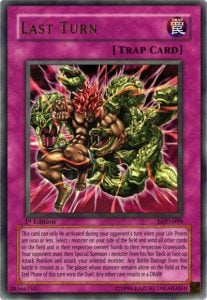 An "Alternate Win Condition" is usually any card which includes "Wins/Loses/Draws the game" in its text box. These include cards like Last Turn or Self-Destruct Button, although some cards such as The Tyrant Neptune (who combos with Lyrilusc - Independent Nightingale) are also here. They are cards which, in certain combos, win the game outright without much room for counterplay from the opponent.
An "Alternate Win Condition" is usually any card which includes "Wins/Loses/Draws the game" in its text box. These include cards like Last Turn or Self-Destruct Button, although some cards such as The Tyrant Neptune (who combos with Lyrilusc - Independent Nightingale) are also here. They are cards which, in certain combos, win the game outright without much room for counterplay from the opponent.Trinity Format aims to be balanced during gameplay. This means that games shouldn't end with a single card activation or combo - the format tries to be more back-and-forth than that. We believe that, even if some "Alternate Win Condition" cards aren't inherently broken, the possibility of a single card or combo being able to end the game on the spot shouldn't be in the format. Ending games quickly is often quite unfun, especially when there's little that the opponent can do to stop these cards/combos.
This isn't to say that "all OTK decks should be banned" or anything of the sort. There are still lots of swingy cards and strategies available to players who enjoy that sort of thing. Only the more oppressive and unfun ones are outright Forbidden.
Unkillable Boss Monsters
This section is more controversial. Many players looking at the Trinity Forbidden List for the first time and question the existence of cards like Raidraptor - Ultimate Falcon on the list. The following is some reasoning as to why cards like this are generally always Forbidden:
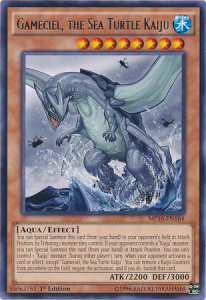
Trinity Format aims to be as diverse as possible. Summoning any Unkillable Boss will, without a doubt, win you the game provided that your opponent doesn't have an out to it. This forces players to commit to side-decking, or even main-decking Kaijus. Forcing players to play very specific cards, in order to not instantly lose against a specific (often easy to summon) boss monster takes away from the diversity of the format. Trinity Format aims to be as diverse as possible.
Trinity shouldn't be full of massive power plays. The easiest out to these cards is with a "Kaiju" Monster (Such as Gameciel, the Sea Turtle Kaiju). However, one ideology within the Trinity format is that games shouldn't be full of massive power plays. Summoning an Unkillable Boss and removing an Unkillable Boss are both "Power Plays" in this sense. Trinity Format is supposed to be more tempo-based than that, hence the banning of most "invincible" Boss Monsters. Trinity Format shouldn't be full of massive power plays.
This isn't to say that regular Yugioh shouldn't have these monsters; this list only affects the Trinity Format. If you're a big fan of decks and strategies which summon big, unkillable monsters, then you're free to play those decks in the TCG or OCG! But if you ever feel the urge to play a format with a lower power level in this regard, Trinity is the place to be.
Oppressive Boss Monsters
Similar to Unkillable Bosses, but much harder to define, are the "Oppressive" Boss monsters. These cards are simply too good. Since they're not really easy to bunch together, I'm going to explain their positioning on the list here individually. Note that this is only going to cover the January 1st List of 2017: If you're reading this in the future, some of the cards listed here might have moved on/off of the list a bit!
Kozmo Dark Destroyer
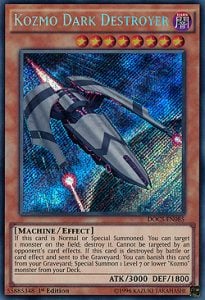
Dark Destroyer is half unkillable Boss monster, Half-Win Condition, and all Value. Trinity aims to be diverse, and not every deck has an out to a 3000 ATK monster that can't be targeted. That in itself is very powerful, but making it both easy to summon (with any "Kozmo" pilot, and with a number of Revival Spell/Trap cards) and giving it build-in Removal is icing on the cake.
Dark Destroyer is simply too oppressive and format warping, while at the same time being very easy to summon. The "Kozmo" deck is still playable with other Boss-esque monsters, through either Kozmo Dark Eclipser (a fairer 3000 ATK non-targetable boss) or Kozmo Forerunner (who can still causes problems for many a deck)!
Chaos Emperor Dragon - Envoy of the End
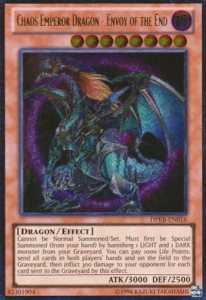
It's important to note that at the time of writing, Chaos Emperor has the old TCG text (as opposed to the OCG errata). This means that it is capable of nuking the board & hands without preventing you from activating other cards and effects in the same turn. Regardless of this card having the TCG or OCG text, a 3000-ATK beater which can be splashed into any deck with access to LIGHT and DARK monsters (Which is quite a lot of decks) is pretty good.
What makes Chaos Emperor ban-worthy, even with the OCG text, is how it puts both players into a top-decking scenario. With no cards in the hand or on the field, games are often reduced to asking "Who drew into the best card the soonest?" which is neither skillful nor fun.
Majespecter Unicorn - Kirin
This is another monster who has both protection and other effects. Kirin has 2000 ATK and can't be destroyed or targeted by card effects. That's not shabby, but what really makes this card busted is the Pendulum Mechanic: Even if it does die, Kirin is easy to recur the following turn - although, it's unlikely to die at all, since it can bounce itself (or another pendulum monster) to get a Compulsory Evacuation Device-like effect on the opponent at Spell Speed 2. Kirin is simply too hard to remove for a recurring threat while also being searchable by a wide variety of Majespecter and generic Pendulum cards. On top of all of this, the card is generally disliked by the community, which is the lock on the door to its place here on the "Forbidden" section of the list.
Orbital Hydralander
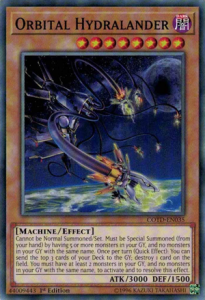
As the name implies, this card was designed for "Highlander" decks: Deck where you only include 1 copy of each card. Trinity is a Highlanderesque format and as such, the biggest restrictions on this card are removed completely. It's easy to summon in practically any deck.
What's notable here is how sending 3 cards from the top of the deck to the Graveyard is very much an upside to the card in many decks. On top of that, the Destruction effect is a quick effect, meaning that you can use it on either player's turn. Unless this card gets hit by a Solemn Warning, it's likely going to win you the game. Destroying 1 card on the field without targeting on each turn on the game - and attached to a 3000 ATK beater - is what makes this card too strong to be unlimited. As the card is Semi-Forbidden, Hydralander is still playable - it's just not as splashable in every deck.
PSY-Frame Lord Omega
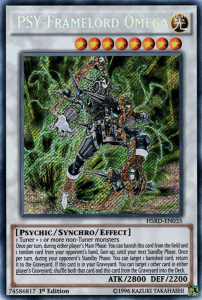
It doesn't gum up your Extra Monster Zone, rips apart the opponent's hand, returns banished monsters to the graveyard, and is a 2800 ATK monster capable of evading destruction.
Omega is the best generic level 8 Synchro in the game, hands down. If your deck can make level 8 Synchro monsters, it should be playing Omega. At least, that was the case until Omega became Semi-Forbidden. Now it's just as powerful, but less splashable. Some decks laugh at the meager cost of 5 extra cards to play an Omega. Others make-do with Stardust Spark Dragon and instead choose to play a Semi-Forbidden Pot of Greed or Graceful Charity. Setting a card to Semi-Forbidden isn't the same as Banning it - doing so just creates more diversity in the format.
Generic Staples
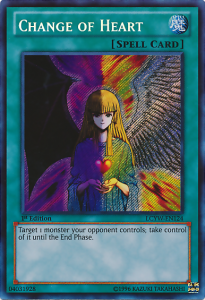
A "Generic" card can be defined as "A card which works independently and does not require any external cards to be used; A card which could potentially benefit any type of deck, regardless of playstyle".
A "Staple" card can be defined as "A card which is so powerful, useful, or versatile, that a typical deck which could include it, but does not include it, is often at an inherent disadvantage, simply because it does not include that card."
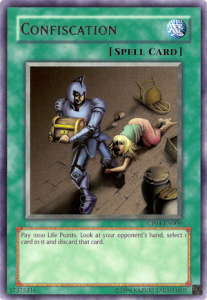
What do you get when you use Polymerization on both of those definitions? You get a card which can go
into every deck, and should go into every deck. That's sometimes fine - Solemn Warning is as close to a "Generic Staple" as unlimited cards get - but if you have a whole bunch of these cards in one format, decks start to look very similar. Trinity aims to be as diverse as possible with minimal expense, and allowing a long list of cards like Change of Heart and Dark Hole to be put into every single deck only helps serve to reduce the diversity of the format. Decklists aren't very interesting when they all start with the same 20 cards.
By moving these cards to Semi-Forbidden, they're no longer "Staples": There's now an opportunity cost associated with them. The cool thing about Trinity is how you can still play with these really strong cards, but doing so isn't always ideal. Having access to the "best" cards in the game helps strengthen weaker decks, while stronger decks usually prefer to play additional copies of unlimited cards to assist in their own strategies.
Floodgates
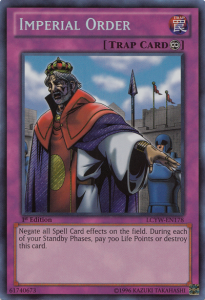
A floodgate is any card (usually a Trap card) which outright stops your opponent from doing something they normally could do. For example, Imperial Order stops your opponent from using Spell Cards, which is going to hurt quite a bit if they play more than a few in-deck.
Floodgates aren't always "broken" or "overpowered", although they oftentimes can be. For example, Vanity's Emptiness is a very powerful card which stops your opponent from doing almost anything with monsters! And that's exactly why Floodgate cards are on the list. They're just not fun to play against. Having your opponent consistently say "no" to everything you do doesn't provide an enjoyable play experience.
Not many Floodgates end up as Forbidden. Most of the ones in Trinity are Semi-Forbidden. This allows for players who happen to really enjoy using floodgates to play one or two in-deck, although with the usual "Extra 5 cards" opportunity cost slapped on top. Note that only the more powerful or wide-reaching Floodgate cards tend to be on the list. Cards like Lose 1 Turn, which don't completely stop as many decks, are kept off the list. It's not really relevant to have them stay on there.
Archetypal Balance
The last reason that cards are put on the list is entirely for balance reasons. Some cards are just too strong to be kept at Unlimited and as such are set to Semi-Forbidden. This is only used to create more diversity and balance in the Trinity metagame.
Occasionally, a card is deemed so powerful and format-warping that it gets outright forbidden, but this isn't usually the case. Rarely, when an archetype is simply too powerful, a single one of its cards is Banned in order to prevent us from having to Semi-Forbid 5+ other cards. This can be seen in cards like Time Pendulumgraph and Edea the Heavenly Squire.
Please note that the entire Trinity Banlist and Ruleset is Community-Built: If you have an opinion on a card - whether you'd like to see it come on or off of the list - Voice your opinion over at the Trinity Discord! new lists come out on the first of every month, in order to keep the format fresh.
Until next time - Stay Groovy!




